Blossoming from the brush of Rubens, Achilles’ life force has rooted itself ever more deeply into history, propagating itself onto sumptuous tapestries, prized possessions adorning European palaces and national museums.
Selecting eight defining scenes from the life of Achilles, Peter Paul Rubens (1577–1640) poured every ounce of his artistic virtuosity into his masterpieces of Western Civilization’s earliest and most enduring hero.
In one for the angst-filled bucket list of lost opportunities, I lately learned that I missed the perfect chance to see them all together in a wonderful museum exhibition, Peter Paul Rubens: The Life of Achilles.

Achilles discovered by Odysseus among the daughters of Lycomedes – modello by Peter Paul Rubens. Source: Wikimedia Commons
Peter Paul Rubens: The Life of Achilles
All eight of Rubens’ scenes were presented in a comprehensive exploration of the artist’s personal interest in Achilles, the visual and literary resources influencing his work, and the technical aspects of executing these incredible masterpieces.
A full suite of finished works, carefully preserved since the last half of the 17th century, were on display. This incuded all of Ruben’s original oil sketches on oak panels, several of his lavishly painted modelli used as references for the weavers’ looms, and many of the original, richly executed tapestries were displayed, as well.
This amazing exhibition took place in the Netherlands at Rotterdam’s Museum Boijmans Van Beuningen from 30 August to 16 November 2003 and then moved to Spain from 9 December to 19 February 2004 at Madrid’s Museo Nacional del Prado.
The accompanying catalog, appropriately entitled, Peter Paul Rubens: The Life of Achilles is written by curators Friso Lammertse and Alejandro Vergara, with contributions by Annetje Boersma, Guy Delmarcel and Fiony Healy. (I’m impatiently awaiting my copy from Amazon)
According to Lammertse, as reported in the catalog publication review by University of Cincinnati’s Kristi Nelson, Rubens’ father-in-law may have been instrumental in the commissioning of these works.
As a top-tier tapestry merchant, Daniel Fourment was closely connected to the Life of Achilles series, and the provenance of many of the original sketches and tapestries is listed as his home.
Rubens Conceived of Tapestry as a Comprehensive Whole
Lammertse explains that Rubens conceived of tapestry as not just individual pieces, but as a comprehensive whole. The architecture of the client’s home or palace where the tapestries would hang was a critical factor in the creative process and final designs.
Delmarcel notes that various famous workshops in Brussels produced their own editions of the Achilles tapestries. Different border designs were often used, perhaps to more closely match the tastes of diverse clients.
Healy suggests that Rubens was likely influenced by original texts, as well as Renaissance publications, for narrative details included in his designs. She stresses the brilliant intuition Rubens displays, producing designs that visually express both the human and heroic qualities of Achilles’ character.
Did Rubens Miss Anything?
As you view the following images, take note of the visual content of the eight separate scenes. Are these the key scenes you would say define the fame of Achilles? If you could commission Rubens, what else would you like to see?
The mourning of Achilles over the death of Patroklos might be an obvious choice, but I’d really like to see what Rubens would have done with this as a starting point for a ninth masterpiece:
 Tondo of an Attic Red-Figure Kylix, ca. 500 BCE, depicting Achilles tending Patroklos’ arm, wounded by an arrow. Source: Wikimedia Commons
Tondo of an Attic Red-Figure Kylix, ca. 500 BCE, depicting Achilles tending Patroklos’ arm, wounded by an arrow. Source: Wikimedia Commons
Also, don’t miss the caption details. You might find it interesting to follow the changes in size from sketch to modello to tapestry, and to notice the artistic changes in border designs as well as other design variations.
From Sketches to Modelli to Full-Scale Tapestries
1. Thetis Dipping the Infant Achilles Into the River Styx:
 Rubens’ Sketch for Thetis dipping the infant Achilles into the river Styx, ca 1630-1635, oil on oak panel. (44.1 × 38.4 cm / 17.4 × 15.1 in) Rotterdam, Museum Boijmans Van Beuningen. Source: Wikimedia Commons.
Rubens’ Sketch for Thetis dipping the infant Achilles into the river Styx, ca 1630-1635, oil on oak panel. (44.1 × 38.4 cm / 17.4 × 15.1 in) Rotterdam, Museum Boijmans Van Beuningen. Source: Wikimedia Commons.
 Rubens’ Modello for Thetis dipping the infant Achilles into the river Styx, ca 1630-1635. (size and current location not stated) oil on canvas. Source: Wikimedia Commons.
Rubens’ Modello for Thetis dipping the infant Achilles into the river Styx, ca 1630-1635. (size and current location not stated) oil on canvas. Source: Wikimedia Commons.
 Wool and silk Tapestry, ca. 1630 – 1699, attributed to Frans and Jan Raes, based on Rubens’ Thetis dipping Achilles in the River Styx. (423 × 362 cm / 13 ft. 10 in × 11 ft. 10 in). Brussels, Koninklijke Musea voor Kunst en Geschiedenis. Source: Wikimedia Commons
Wool and silk Tapestry, ca. 1630 – 1699, attributed to Frans and Jan Raes, based on Rubens’ Thetis dipping Achilles in the River Styx. (423 × 362 cm / 13 ft. 10 in × 11 ft. 10 in). Brussels, Koninklijke Musea voor Kunst en Geschiedenis. Source: Wikimedia Commons
2. Achilles Educated by the Centaur Chiron:
 Rubens’ sketch for Achilles Educated by the Centaur Chiron ca. 1630-1635, oil on oak panel. (44 × 38.5 cm / 17.3 × 15.2 in) Rotterdam, Museum Boijmans Van Beuningen. Source: Wikimedia Commons
Rubens’ sketch for Achilles Educated by the Centaur Chiron ca. 1630-1635, oil on oak panel. (44 × 38.5 cm / 17.3 × 15.2 in) Rotterdam, Museum Boijmans Van Beuningen. Source: Wikimedia Commons
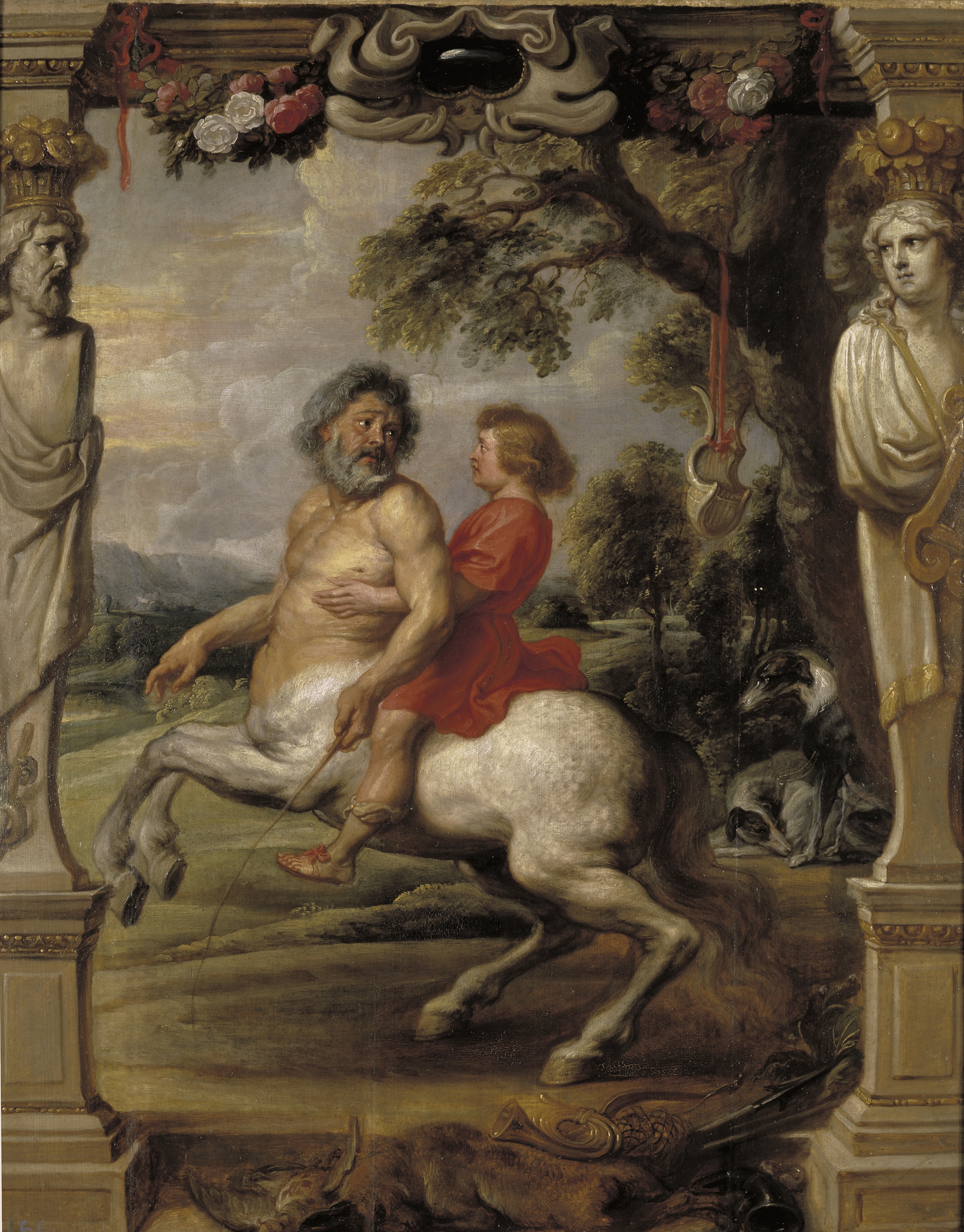 Rubens’ modello for Achilles Educated by the Centaur Chiron ca. 1630-1635. (size not stated) oil on canvas. Madrid, Museo Nacional del Prado. Source: Wikimedia Commons
Rubens’ modello for Achilles Educated by the Centaur Chiron ca. 1630-1635. (size not stated) oil on canvas. Madrid, Museo Nacional del Prado. Source: Wikimedia Commons
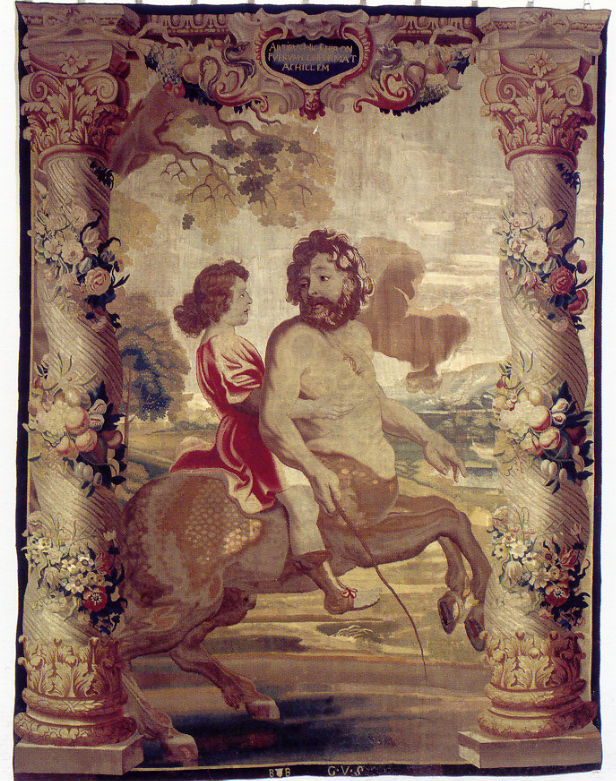 Tapestry of wool and silk attributed to Geraert Van Der Strecken, ca. 1675-1699, (259 cm x 351 cm / 8 ft. 6 in x 11 ft. 6 in) based on Rubens’ Achilles Educated by the Centaur Chiron. Source: Wikimedia Commons
Tapestry of wool and silk attributed to Geraert Van Der Strecken, ca. 1675-1699, (259 cm x 351 cm / 8 ft. 6 in x 11 ft. 6 in) based on Rubens’ Achilles Educated by the Centaur Chiron. Source: Wikimedia Commons
3. Achilles Recognized Among the Daughters of Lycomedes:
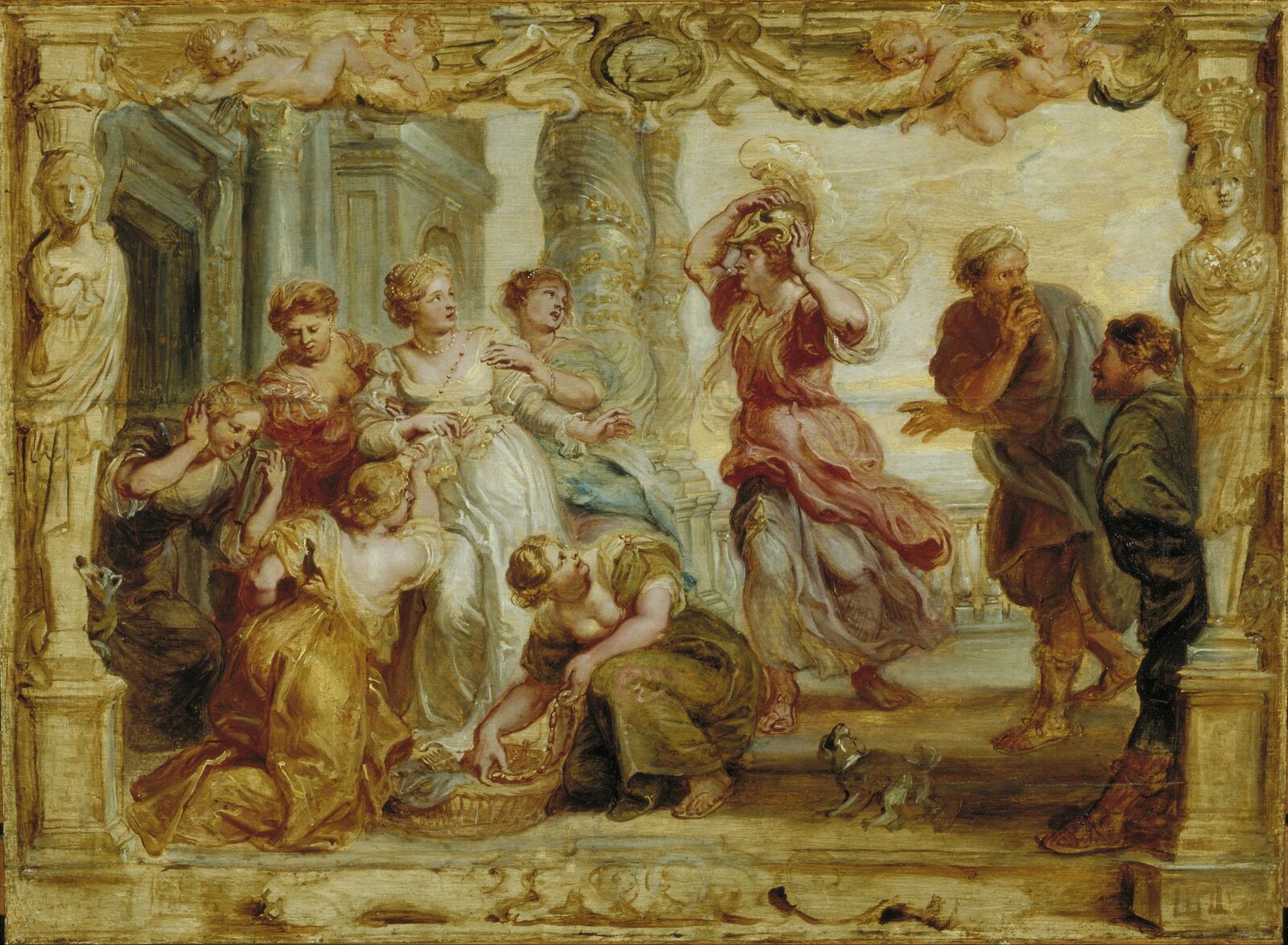 Rubens’ sketch for Achilles Recognized Among the Daughters of Lycomedes ca. 1630-1635, oil on oak panel. (45.5 × 61.2 cm / 17.9 × 24.1 in) Rotterdam, Museum Boijmans Van Beuningen. Source: Wikimedia Commons
Rubens’ sketch for Achilles Recognized Among the Daughters of Lycomedes ca. 1630-1635, oil on oak panel. (45.5 × 61.2 cm / 17.9 × 24.1 in) Rotterdam, Museum Boijmans Van Beuningen. Source: Wikimedia Commons
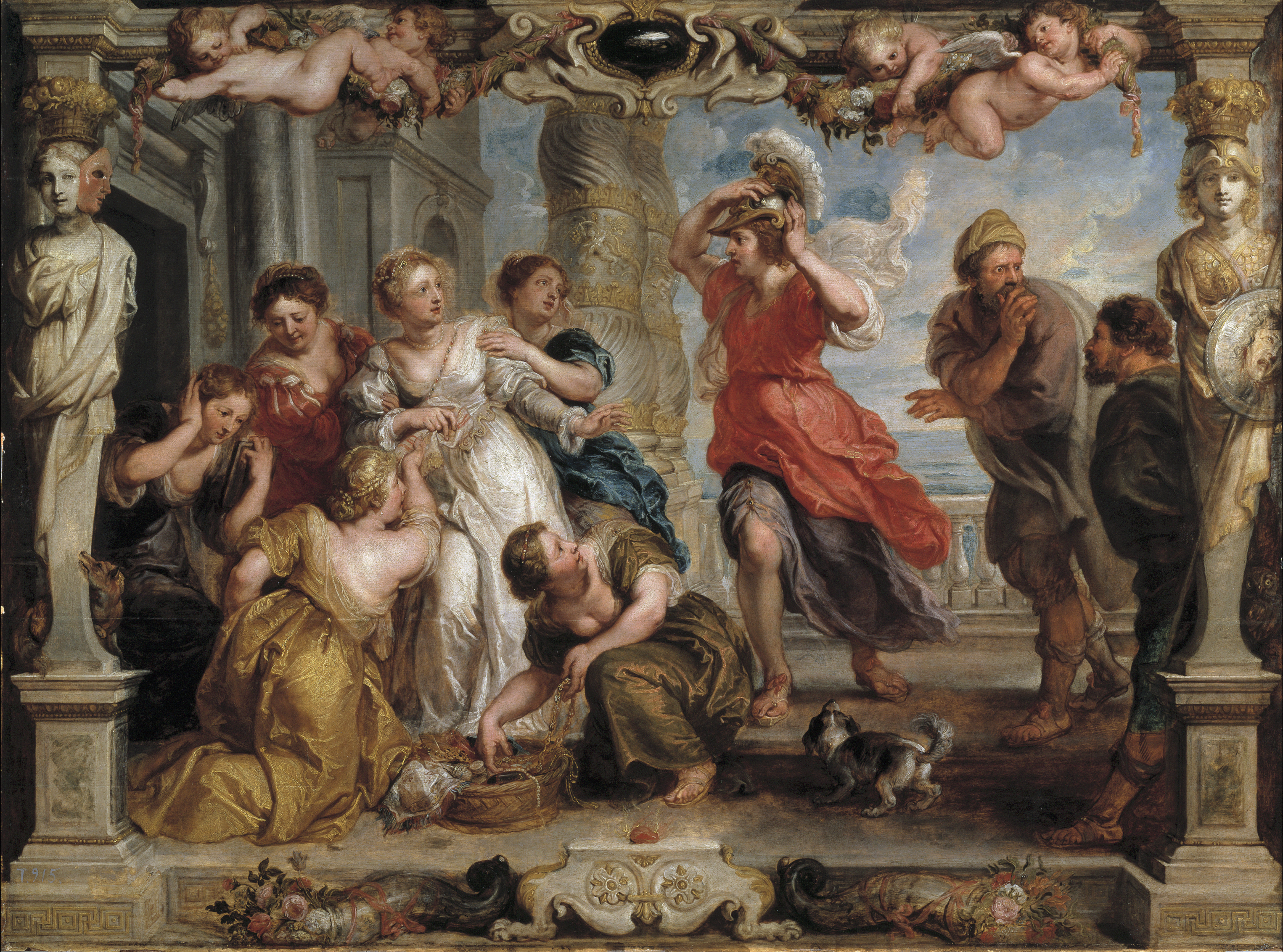 Rubens’ modello for Achilles Recognized Among the Daughters of Lycomedes. ca. 1630-1635, (size not stated) oil on canvas. Madrid, Museo Nacional del Prado. Source: Wikimedia Commons
Rubens’ modello for Achilles Recognized Among the Daughters of Lycomedes. ca. 1630-1635, (size not stated) oil on canvas. Madrid, Museo Nacional del Prado. Source: Wikimedia Commons
 Tapestry of wool and silk, ca. 1653-1664, attributed to Jan van Leefdael. Based on Rubens’ Achilles Recognized Among the Daughters of Lycomedes. (495 × 607 cm / 16 ft. 2 in × 19 ft. 10 in). Antwerp, Rubenshuis. Source: Wikimedia Commons
Tapestry of wool and silk, ca. 1653-1664, attributed to Jan van Leefdael. Based on Rubens’ Achilles Recognized Among the Daughters of Lycomedes. (495 × 607 cm / 16 ft. 2 in × 19 ft. 10 in). Antwerp, Rubenshuis. Source: Wikimedia Commons
4. The Wrath of Achilles:
 Rubens’ sketch for The Wrath of Achilles, ca. 1630-1635, oil on oak panel. (45 × 46 cm / 17.7 × 18.1 in). Rotterdam, Museum Boijmans Van Beuningen. Source: Wikimedia Commons
Rubens’ sketch for The Wrath of Achilles, ca. 1630-1635, oil on oak panel. (45 × 46 cm / 17.7 × 18.1 in). Rotterdam, Museum Boijmans Van Beuningen. Source: Wikimedia Commons
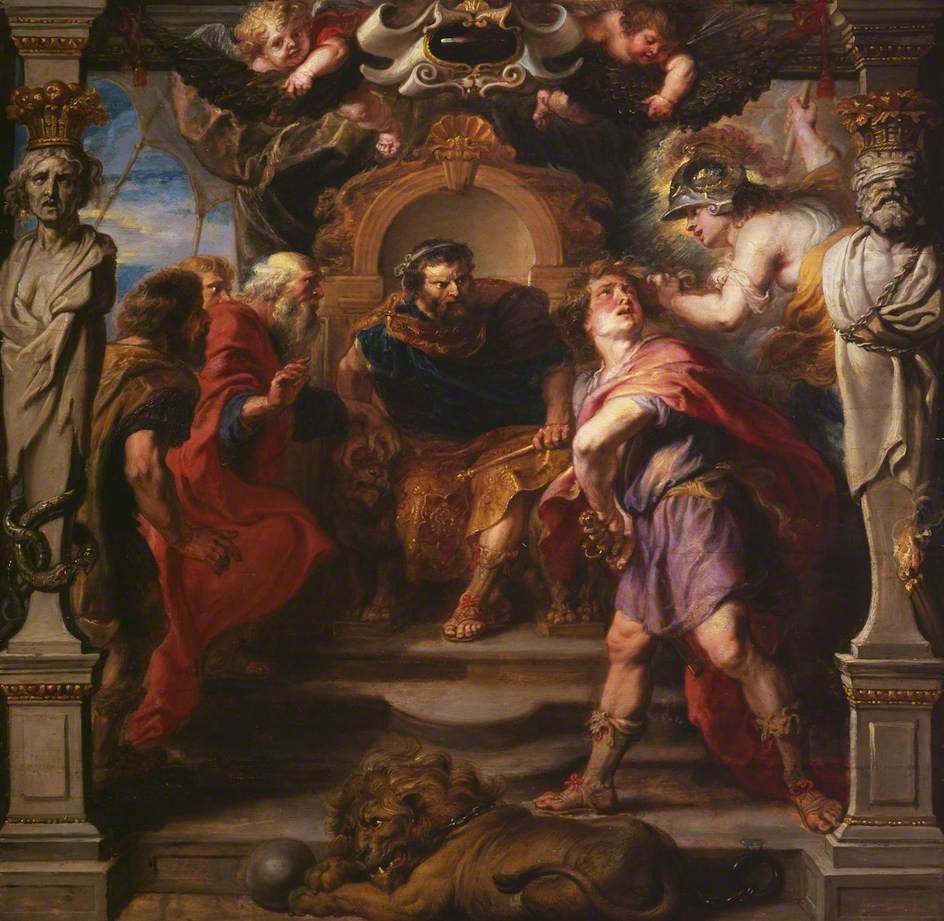 Rubens’ modello for The Wrath of Achilles, ca. 1630-1635, (108.5 cm x 106.8 cm / 42.7 in x 42 in) oil on canvas. London, The Courtauld Gallery. Source: Wikimedia Commons
Rubens’ modello for The Wrath of Achilles, ca. 1630-1635, (108.5 cm x 106.8 cm / 42.7 in x 42 in) oil on canvas. London, The Courtauld Gallery. Source: Wikimedia Commons
 Tapestry of wool and silk, with gold and silver threads attributed to the workshop of Daniël Eggermans based on Rubens’ The Wrath of Achilles. ca. 1630-1635. (417 cm × 390 cm / 13 ft. 8 in × 12 ft. 9 in). Rotterdam, Museum Boijmans Van Beuningen. Source: Wikimedia Commons
Tapestry of wool and silk, with gold and silver threads attributed to the workshop of Daniël Eggermans based on Rubens’ The Wrath of Achilles. ca. 1630-1635. (417 cm × 390 cm / 13 ft. 8 in × 12 ft. 9 in). Rotterdam, Museum Boijmans Van Beuningen. Source: Wikimedia Commons
 Tapestry of wool and silk, attributed to Frans Raes based on Rubens’ The Wrath of Achilles. (400 cm × 390 cm / 13 ft. 1 in × 12 ft. 9 in). Brussels, Royal Museums of Art and History. Source: Wikimedia Commons
Tapestry of wool and silk, attributed to Frans Raes based on Rubens’ The Wrath of Achilles. (400 cm × 390 cm / 13 ft. 1 in × 12 ft. 9 in). Brussels, Royal Museums of Art and History. Source: Wikimedia Commons
5. Briseis Restored to Achilles:
 Rubens’ sketch for Briseis Restored to Achilles, ca. 1630-1631 oil on oak panel (45.4 cm x 67.6 cm / 17.9 in x 26.6 in), Rotterdam, Museum Boijmans Van Beuningen. Source: Wikimedia Commons
Rubens’ sketch for Briseis Restored to Achilles, ca. 1630-1631 oil on oak panel (45.4 cm x 67.6 cm / 17.9 in x 26.6 in), Rotterdam, Museum Boijmans Van Beuningen. Source: Wikimedia Commons
 Rubens’ modello for Briseis Restored to Achilles. ca. 1630-1635, (size not stated) oil on canvas. Madrid, Museo Nacional del Prado. Source: Wikimedia Commons
Rubens’ modello for Briseis Restored to Achilles. ca. 1630-1635, (size not stated) oil on canvas. Madrid, Museo Nacional del Prado. Source: Wikimedia Commons
 Tapestry of wool and silk attributed to Frans and Jan Raes, ca. 1650, based on Rubens’ Briseis Restored to Achilles. (416 cm × 593 cm / 13 ft. 7 in × 19 ft. 5 in). Brussels, Koninklijke Musea voor Kunst en Geschiedenis. Source: Wikimedia Commons
Tapestry of wool and silk attributed to Frans and Jan Raes, ca. 1650, based on Rubens’ Briseis Restored to Achilles. (416 cm × 593 cm / 13 ft. 7 in × 19 ft. 5 in). Brussels, Koninklijke Musea voor Kunst en Geschiedenis. Source: Wikimedia Commons
6. Thetis Receiving the Arms of Achilles from Vulcanus:
 Rubens’ sketch for Thetis Receiving the Arms of Achilles from Vulcanus ca. 1630-1635, oil on oak panel (44.6 × 53.4 cm / 17.6 × 21 in). Rotterdam, Museum Boijmans Van Beuningen. Source: Wikimedia Commons
Rubens’ sketch for Thetis Receiving the Arms of Achilles from Vulcanus ca. 1630-1635, oil on oak panel (44.6 × 53.4 cm / 17.6 × 21 in). Rotterdam, Museum Boijmans Van Beuningen. Source: Wikimedia Commons
 Rubens’ modello for Thetis Receiving the Arms of Achilles from Vulcanus ca. 1630-1635, oil on canvas (size not stated). Pau, France, Musee’ des Beaux-arts de Pau. Source: Wikimedia Commons
Rubens’ modello for Thetis Receiving the Arms of Achilles from Vulcanus ca. 1630-1635, oil on canvas (size not stated). Pau, France, Musee’ des Beaux-arts de Pau. Source: Wikimedia Commons
(Unfortunately, no image of a tapestry of Thetis Receiving the Arms of Achilles from Vulcanus could be found online)
7. The Death of Hector:
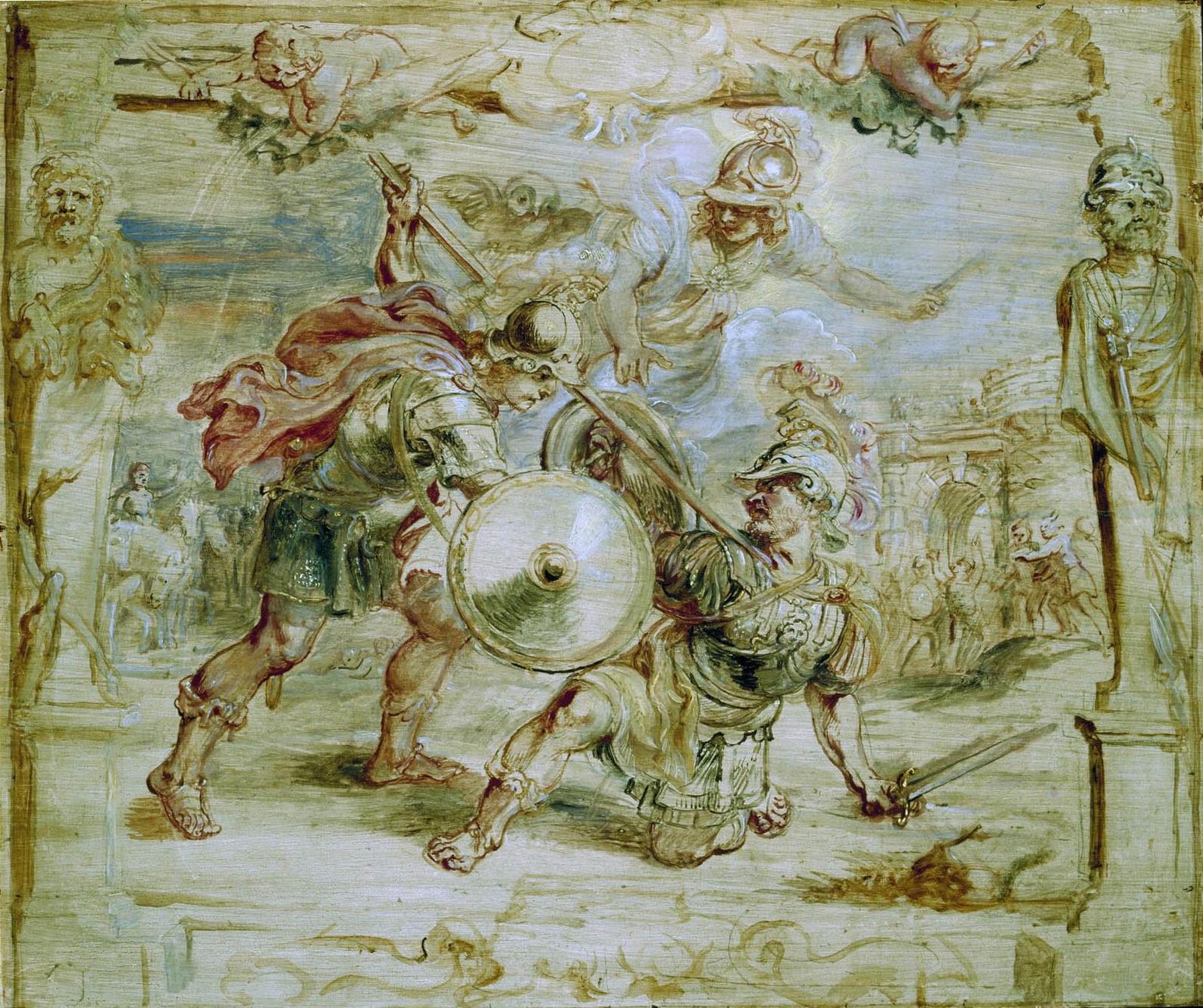 Rubens’ sketch for The Death of Hector, ca. 1630-1635, oil on oak panel. (44.4 × 53 cm / 17.5 × 20.9 in) Rotterdam, Museum Boijmans Van Beuningen. Source: Wikimedia Commons
Rubens’ sketch for The Death of Hector, ca. 1630-1635, oil on oak panel. (44.4 × 53 cm / 17.5 × 20.9 in) Rotterdam, Museum Boijmans Van Beuningen. Source: Wikimedia Commons
 Rubens’ modello for The Death of Hector. ca. 1630-1635, (size and current location not stated) oil on canvas. Source: Wikimedia Commons
Rubens’ modello for The Death of Hector. ca. 1630-1635, (size and current location not stated) oil on canvas. Source: Wikimedia Commons
Tapestry of wool and silk; date, attribution, and size not stated, based on Rubens’ The Death of Hector, Royal Palace of Turin. Source: Wikimedia Commons
8. The Death of Achilles:
 Rubens’ sketch for The Death of Achilles, ca. 1630-1635, oil on oak panel, (45.3 × 46 cm / 17.8 × 18.1 in) Rotterdam, Museum Boijmans Van Beuningen. Source: Wikimedia Commons
Rubens’ sketch for The Death of Achilles, ca. 1630-1635, oil on oak panel, (45.3 × 46 cm / 17.8 × 18.1 in) Rotterdam, Museum Boijmans Van Beuningen. Source: Wikimedia Commons
 Rubens’ modello for The Death of Achilles, ca. 1630-1635, (107.5 cm x 109.2 cm / 42.2 in x 43 in) oil on canvas. London, The Courtauld Gallery. Source: Wikimedia Commons
Rubens’ modello for The Death of Achilles, ca. 1630-1635, (107.5 cm x 109.2 cm / 42.2 in x 43 in) oil on canvas. London, The Courtauld Gallery. Source: Wikimedia Commons

Tapestry of wool and silk attributed to Jan Raes,ca. 1630 based on Rubens’ The Death of Achilles (411 cm x 462 cm / 13 ft. 1 in x 12 ft. 9 in) Brussels, Royal Museums of Art and History. Source: Wikimedia Commons
 Tapestry of wool and silk attributed to Gerard Peemans, ca. 1655-1693, based on Rubens’ The Death of Achilles, (410 cm × 427 cm / 13 ft. 5 in × 14 ft. 0.1 in). Antwerp, Rubenshuis. Source: Wikimedia Commons
Tapestry of wool and silk attributed to Gerard Peemans, ca. 1655-1693, based on Rubens’ The Death of Achilles, (410 cm × 427 cm / 13 ft. 5 in × 14 ft. 0.1 in). Antwerp, Rubenshuis. Source: Wikimedia Commons
The Significance of Rubens’ Life of Achilles
With a monumental body of works numbering 1,403 pieces, not including the numerous copies made in his workshop, Rubens’ Life of Achilles series represents an almost insignificant fraction.
And yet, despite the small number of pieces, the impact of Rubens’ contribution to Achilles’ perpetual fame is hardly insignificant.
Blossoming from the brush of Rubens, Achilles’ life force has rooted itself ever more deeply into history, propagating itself onto magnificent tapestries considered as prized possessions by royals and art collectors alike.
Adorning the gilded walls of European palaces and grand national museums of art and history, Rubens’ extraordinary artworks offer shining proof that Achilles’ prophesied fate is still flourishing vigorously.
Achilles’ kleos aphthiton, or “unwilting glory” as eloquently translated by Prof. Gregory Nagy, is still perpetuating, still blooming gloriously, generation after generation, throughout the ages.
Peter Paul Rubens’ Life of Achilles masterpieces are highly significant for contributing to this continuity, visually perpetuating our perennial love for Homer’s Shining Prince Achilles.
And, like the beloved bones of Patroklos mingling through eternity in the burial urn with Achilles’, Rubens’ reward is a similar kleos— his fate has become gloriously interwoven with the fate of Achilles.
 Rubens’ modello for Briseis Restored to Achilles. ca. 1630-1635, (size not stated) oil on canvas. Madrid, Museo Nacional del Prado. Source: Wikimedia Commons
Rubens’ modello for Briseis Restored to Achilles. ca. 1630-1635, (size not stated) oil on canvas. Madrid, Museo Nacional del Prado. Source: Wikimedia Commons



Thank you for such wonderful pictures, truly amazing ! and I love them all because Achilles is one of my favourite people. When I first moved to Crete I bought a a lovely bronze statue of him. It’s difficult to choose a favourite amongst these tapestries and paintings but I think I like the one “The death of Hector” maybe because it’s the most popular. Hope you are O.K. and enjoyed your visit to Egypt, or are you still there?
LikeLiked by 1 person
Hi Rita, I’d love to see a photo of your statue! Me, too, I can’t pick a favorite from Rubens’ paintings of Achilles, but I crack up whenever I see the paintings of Achilles in drag on Skyros lol! We had a wonderful time in Egypt but we’re back now. I hope in the future we will be able to coordinate visits with you – maybe you will like to visit Egypt sometime! Hope your coming holidays are beautiful there in Crete ☺☺☺
LikeLike
[…] Source: The Life of Achilles by Peter Paul Rubens […]
LikeLiked by 1 person
Hi Kathleen, Of course I will send a photo of my statue. I think I have your e mail so will send it there O.K. When we visited Egypt a few years ago my partner John was ill for most of the time, not with a bug it was a serious throat problem, so he missed the Valley of the Kings. What is the situation in Egypt now, is it dangerous? Weather here in Crete is much cooler now and much more comfortable, for me anyway. Love your blog it is very professional and so interesting.
LikeLiked by 1 person
Hi Rita, I’m glad you’re enjoying nicer weather now–this is also the best time to visit Egypt too. I found Cairo looking cleaner and safer this time more than any other time we’ve been there. It was quite surprising and impressive! A professional tour is the best way to enjoy Egypt with the highest degree of safety, though. Sorry to hear about John’s throat trouble, I guess that was really stressful for both of you. I’ve never been to Luxor-one of the tiny clauses in the fine print of my marriage contract, lol, noted that my husband has already sported so many family members and friends to the tourist traps that he is sick of it all! I finagled a good time in lCairo and Giza for our honeymoon and several beautiful trips to Alexandria, but time will tell if we ever book a trip to Luxor!
🐫🐫🐫 i’s definitely on my list, tho!
LikeLiked by 1 person
Brilliant post,great theme based on the Homeric epic poem.Compelling compilation of glorious Rubens’ painting and tapestries.Keep triumphantly going,most remarkable work.Kudos 🙂
LikeLiked by 1 person
Thanks so much, dear Doda, I appreciate your support and am very happy to “see” you here! Sending smiles and best wishes! 😃😃😃❤️
LikeLiked by 1 person
Greetings,
My wife and I had the pleasure of seeing these tapestries some years. The size and skill are mine-boggling. Yes I bought the book. If I can offer an insight. So the paintings are blue prints for the tapestries, right? Note the little cherubs at that top of the paintings. They are not decorative. They are holding up the finished tapestries. The painting are actually paintings of the finished products
LikeLiked by 1 person
Thanks so much for sharing your insights, William. What a great opportunity for you and your wife to see these tapestries!
LikeLike